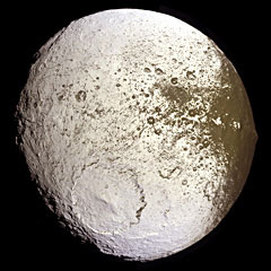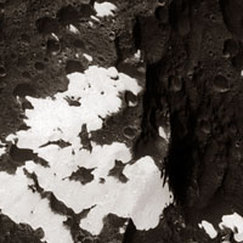Our Solar System
Iapetus

Iapetus is the third-largest moon of Saturn. It is best known for its dramatic 'two-tone' coloration. Its density is similar to that of Rhea, indicating that it has a small allotment of rocky materials. Its leading side is dark with a slight reddish color while its trailing side is bright. The dark surface might be composed of matter that was either swept up from space or oozed from the moon's interior. The real reason is still unknown. The dark material might be a thin layer of organic material perhaps similar to the complex substances found in the most primitive meteorites. However, there are no bright rimed craters present on the dark hemisphere. If the dark material is thin, it must be constantly renewed since a meteor impact would punch through the layer to reveal brighter surface material.
Temperatures on the dark region's surface reach 130 K (−143 °C; −226 °F) at the equator, as heating is made more effective by Iapetus's slow rotation. The brighter surfaces absorb less sunlight so temperatures there only reach about 100 K (−173 °C; −280 °F).
Temperatures on the dark region's surface reach 130 K (−143 °C; −226 °F) at the equator, as heating is made more effective by Iapetus's slow rotation. The brighter surfaces absorb less sunlight so temperatures there only reach about 100 K (−173 °C; −280 °F).
A Moon of Contrast

Iapetus is probably the most unusual of Saturn's moons. It has a low density similar to that of Rhea. This indicates that it contains very little rocky material and is composed mainly of water ice. Iapetus is a moon of stark contrasts. Its leading hemisphere is very dark with a slight reddish color, while its trailing hemisphere is very bright. The dark area is one of the darkest terrains in the Solar System, and is darker than asphalt. The reason for this dark matter on the leading side is not known. It could be composed of dark matter swept up from space, or it could be something that flowed out from within the moon. Some astronomers believe that the dark matter could have originated on Saturn's moon, Phoebe. Phoebe has a low albedo. Material could have been blasted into space by impacts, where it was then deposited on the surface of Iapetus. One problem with this theory, however, is that the color of the material on Phoebe and Iapetus do not match. Another theory states that this dark material may have been formed by eruptions of methane from deep within the moon. The fact that this area is fairly devoid of craters would suggest that this material is replenished regularly. One puzzling aspect of this phenomenon is that the dividing line between the dark and light areas is extremely sharp. No one seems to know why.
Features of Iapetus

The dark, smooth region of Iapetus is known as the Cassini Regio. Very few craters can be found in this region. Astronomers believe that the dark material that covers this region is continually being replenished, thus covering any new craters that may appear. On the opposite side of Iapetus lies the Roncevaux Terra. This region is littered with hundreds of craters. The largest of these craters is known as Roland and is 90 miles (144 km) in diameter. The second largest crater in this area, called Marsilion, is 84 miles (136 km) in diameter. Iapetus has no detectable atmosphere and no magnetic field.
Statistics for Iapetus
Discovered by - Giovanni Cassini
Year of Discovery - 1671
Diameter - 914.6 miles (1,472 km)
Mean Distance from Saturn - 2,212,801 miles (3,561,300 km)
Rotational Period - 79.33 Days
Orbital Period - 79.33 Days
Orbital Eccentricity - 0.0283
Orbital Inclination - 14.72 degrees
Mean Surface Temperature - -280 F (-173 C)
Main Atmospheric Component - None
Apparent Magnitude - 10.2
Year of Discovery - 1671
Diameter - 914.6 miles (1,472 km)
Mean Distance from Saturn - 2,212,801 miles (3,561,300 km)
Rotational Period - 79.33 Days
Orbital Period - 79.33 Days
Orbital Eccentricity - 0.0283
Orbital Inclination - 14.72 degrees
Mean Surface Temperature - -280 F (-173 C)
Main Atmospheric Component - None
Apparent Magnitude - 10.2
